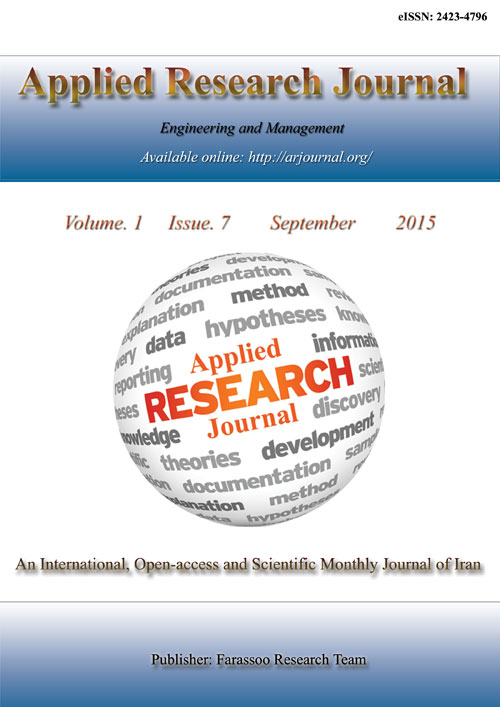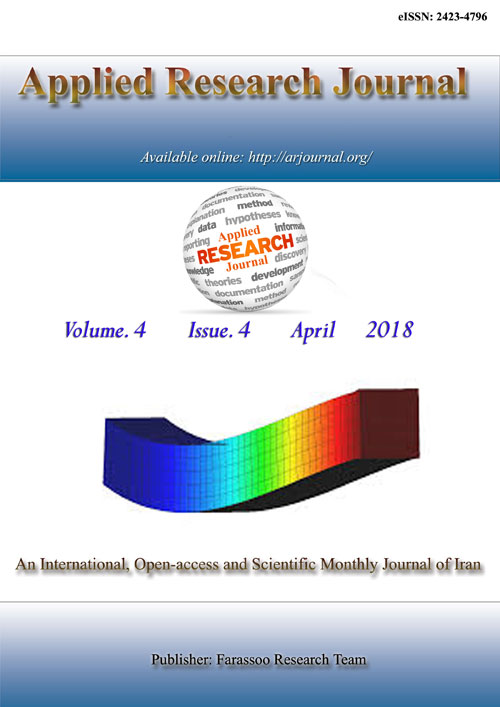فهرست مطالب

Applied Research Journal
Volume:1 Issue: 7, Sep 2015
- تاریخ انتشار: 1394/07/10
- تعداد عناوین: 6
-
Pages 378-383In an attempt to contribute to environmental pollution control measures, relative tolerance of six selected tree species namely; Anacardium occidentale, Azadiracta indica, Cassia angustifolia, Eucalyptus spp, Khaya senegalensis, Mangifera indica from three selected locations of high, moderate, and low pollution rate in Maiduguri City was determined. The plants were selected based on their relative abundance in the locations. The Ascorbic acid content (AAC), pH, Relative water content (RWC), Total chlorophyll content and Air Pollution Tolerance Index (APTI) was evaluated based on the measured physiological and biochemical parameters. The study revealed that Mangifera indica (30.02) and Anacardium occidentale (29.65) are tolerant species, Khaya senegalensis(28.61) Azadiracta indica(28.23) and Eucalyptus spp(24.10) are intermediate and Cassia angustifolia(25.129) is sensitive. Therefore these tree species could be used as bio indicators in pollution monitoring.Keywords: Air pollution, Relative water content, Total chlorophyll content, Ascorbic acid, pH
-
Pages 384-387Preliminary test for presence of phyto-constituents and antimicrobial activities against Escherichia coli, Staphylococcus aureus, Pseudomonas aeruginosa, Enterococcus sp. and Salmonella sp. of hexane extracts of three different cultivar of finger millet [Eleusine coracana (L.) Gaertn.] and pearl millet [Pennisetum glaucum (L.) R. Br.] were performed. Observations revealed that the selected millets have good antimicrobial activities against the studied microorganisms. In both of the selected millets substantial amount of phytoconstituents like flanonoids, terpenoids, steroids, tannins and saponins was found. These secondary metabolites not only precious in fitness and survival of these plants but also they have great potential for pharmaceutical uses in medicine and reciprocal drugs.Keywords: Antimicrobial activities, Finger millet, Health benefits, Pearl millet, Phytochemical
-
Pages 388-394Microbial proteases contribute nearly 40% of the total worldwide enzyme market. Hence, with the view of this significance, objective of the present study was to isolate and optimize the protease production from soil borne bacteria. Soil is the ideal habitat for many extracellular enzyme producing bacteria therefore soil samples were collected from two different sites of Banasthali University and bacteria were isolated by serial dilution agar plate technique. Isolated bacteria were screened on gelatin agar medium for proteolytic activity. Based on the results of primary screening 4 bacterial isolates from soil sample 1 and 4 bacterial isolates from soil sample 2 were selected for protease production in production medium. Four bacterial isolates from soil sample 1 were named as AKS-1, AKS-2, AKS-3 and AKS-4, respectively. Four bacterial isolates from soil sample 2 were named as AKS-5, AKS-6, AKS-7 and AKS-8, respectively. Isolate AKS-4 exhibited maximum protease activity (44.89 U/mL) after 48 h of incubation and isolate AKS-2 was producing minimum protease activity (2.37 U/mL) after 72 h of incubation. Isolate AKS-6 exhibited maximum protease activity (37.94 U/mL) after 3 days of incubation and isolate AKS-8 was producing minimum protease activity (1.22 U/mL) after 3 days of incubation. Hyper producing isolates (AKS-4 and AKS-6) from both soil samples were selected for optimization study. The optimum conditions for protease production by isolate AKS-4 were found to be at pH 8.5 after 5 days of incubation using glucose as carbon source and casein as nitrogen source. Maximum yield of enzyme was obtained by isolate AKS-6 at pH 10.5 after 5 days of incubation using starch as carbon source and casein as nitrogen source. Among all studied bacterial isolates, the maximum protease activity (52.29 U/mL) was recorded in isolate AKS-4 after optimization of culture conditions.Keywords: Proteolytic activity, optimization, production, proteolytic bacteria, bacterial isolates, AKS
-
Pages 395-402The liquid asphalt binder loses its volatiles slowly and continuously during its service life as a soil stabilizer under environmental and service impacts. This will results in loss of elastic properties, and initiation of micro cracks, which is considered as the start of distress for the whole pavement layers. Asphalt treated material can heal by themselves in slow process under repeated loading at ambient temperature. The micro cracks healing phenomena can increase the lifetime of asphalt treated layer for several years. The aim of this work was to investigate the impact of implication of Nano material additives in the self-healing phenomena of asphalt stabilized subgrade soil. Specimens of 100 mm diameter and 75 mm of height have been prepared and compacted at the target density and optimum asphalt content using various percentages and types of Nano materials (Hydrated lime, silica fumes, and coal fly ash). Specimens were subjected to the repeated indirect tension in the Pneumatic repeated load system (RPLS) at 20 ° C for 30 minutes to allow the initiation of micro cracks. Specimens were withdrawn from the testing chamber and stored in an oven for 120 minutes at 60 ° C to allow for crack healing phenomena. Specimens were returned to the testing chamber and subjected to another cycle of repeated indirect tension at 20 ° C for 30 minutes. The deformation of the specimens under repeated indirect tensile stress was captured using video camera for both conditions. The impact of Nano additives on the crack healing was detected through the variation of the strain level of the specimens before and after healing.Keywords: Asphalt stabilization, Indirect tensile stress, Punching shear stress, Repeated load, Crack healing
-
Pages 403-407Soil organic carbon is an import factor for soil health and its degradation affects several soil functions. Field experiment was carried out to investigate the effects of crop residue management on soil organic carbon at the research fields of CSIR-Crops Research Institute at Fumesua in the Ashanti Region of Ghana. The experiment was laid in Split Plot in Randomized Complete Block Design with four replications. Till (residue incorporation) and no till (residue mulch) were on the main plots while sub plots comprises the cowpea residue, maize straw, elephant grass, cattle manure and control (nothing was applied). The two tillage methods did not show any significant differences however no till gave the highest values of 1.87, 1.70, and 1.58 in the three seasons. The maize residue had the highest average soil organic carbon of 1.92 for the first season and cattle manure was the highest in the second and the third season with values 1.83 and 1.74, respectively and the control was the least in season one, two and three with the values of 1.34, 1.20, and 0.97, respectively. The residue treatments and the cattle manure were significantly higher than the control. The crop residues and cattle manure reduced the rate of soil organic carbon loss.Keywords: Carbon stock, Carbon sequestration, Conservation tillage
-
Pages 408-421This paper studies the applying of the controller in the suspension system of car. In order to deal with disturbances and uncertainties, the sliding mode control method has been used as a resistant method as well as a controlling method applied on system. This controller with a Quarter model of car uses the mathematical linear combination of an ideal model Sky-hook and an ideal model Ground-hook as a reference model that this reference model causes to simultaneously have both factors of the comfort of car passengers and more proper conductibility. Stimulation of the suspension system of car causes the effect of applied controller on the dynamics of car’s cabin and dynamics of its wheel. In this paper, both stable and transient states have been used as the stimulation entering to the system and the effects of both states on dynamics of car’s cabin and its wheel have been investigated. The obtained results show that there are states in which there is the equilibrium between the appropriate response of car’s cabin and its wheel. This balance causes the shift in emphasis of reference model on the controllers of sky-hook and Ground-hook through changing the advantage of dual controller.Keywords: Semi, active damper, Magneto, Rhological fluid, dual reference model, comfort of car's passengers, stable stimulation, transient stimulation


